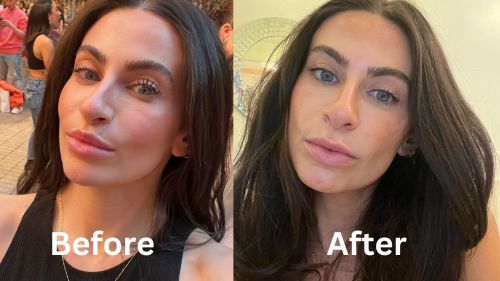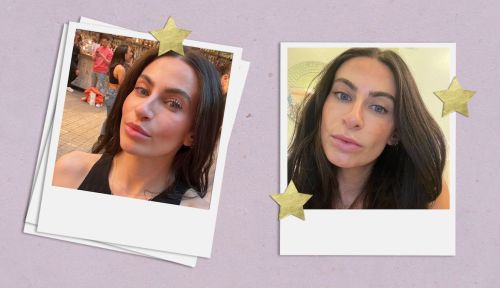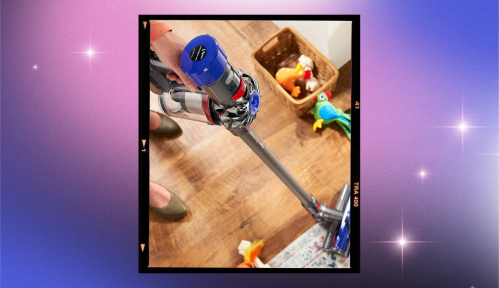I’m no stranger to neuromodulators and other cosmetic injectables, but I recently decided to go deeper—quite literally—with my tweakment routine. After seeing celebs sing the praises of Morpheus 8, a collagen-stimulating treatment that pairs microneedling with radiofrequency, I began to toy with the idea of testing it out for myself. Though I’d heard it was painful (not to mention expensive), I was curious about whether or not it could really deliver all the firming-and-plumping benefits the beauty world had been raving about. So I put my fears aside and booked an appointment.
Below, learn everything you need to know about the treatment, plus see exactly what happened when I tried it.
What is Morpheus 8?
Think of Morpheus 8 as your standard microneedling treatment with the intensity turned all the way up. “It uses microneedles with radiofrequency waves that are applied to the skin, which creates a controlled injury or series of micro-wounds that start at the skin’s surface and go into deeper layers of the skin,” says board-certified dermatologist Corey L. Hartman, MD, Founder of Skin Wellness Dermatology in Birmingham, AL. “It’s these controlled injuries that trigger the body’s natural immune response, stimulating the production of collagen.”
This influx of wound-healing collagen results in plumper, firmer skin, which is why the treatment has come to be known as a “non-surgical facelift.” It can also help to reduce the appearance of textural issues like acne scarring, fine lines, and wrinkles. As an added bonus, the device can be used anywhere on the body to tighten lax or sagging skin and fade stretch marks.
Though there are similar devices on the market—such as Genius RF, Ultherapy, Vivace, and Profound RF—Morpheus 8 is considered to be one of the most powerful radiofrequency microneedling treatments available. It penetrates the skin deeper than the other options (at around 8mm, says Dr. Robert Schwarcz. MD, a double-board certified oculofacial plastic surgeon) to deliver meaningful results after two to four sessions.
Who is a good candidate for Morpheus 8?
“Morpheus 8 is safe for all skin types and tones,” says Dr. Hartman. “For patients in their 20s and 30s, we might be treating more acne scars and uneven skin texture, whereas patients in their 40s and beyond most commonly look to Morpheus 8 to tighten the skin where it is common for skin to droop due to age, [mainly] the jawline, face, and neck.”
He adds that the best patients for Morpheus 8 are those that have mild to moderate skin laxity, which is why younger patients tend to have better results from the procedure (because they have more naturally-occurring collagen in their skin). Also, those that are looking to fix fine lines, wrinkles, sun damage, acne scarring, and those looking for an overall improvement in the look of their skin are good candidates for Morpheus 8.
“Patients with severe sagging of the skin will not see the same benefit as patients with mild skin laxity; for those patients, we will look for other surgical options,” says Dr. Hartman. In other words, Morpheus 8 will not substitute for a facelift if your concern is severe sagging.
How much does Morpheus 8 cost, and how many sessions do you need?
The cost of the Morpheus 8 treatment depends upon who you go to and where you go for the treatment, as well as what area of the body you are treating, or if you are treating multiple areas of the body at once, such as face and neck. Generally, the average cost for each session can range from $750 to $1,700.
This Parisian Skincare Brand Is Launching in the United States for the First Time—Here’s What a Derm Wants You to Know

We’re Calling It: Cleansing Balms Are the Face Wash of the Future—Here Are 3 to Add to Your Cart

This Is the One Product That Scarlett Johansson Always Keeps in Her Purse and on Her Bedside Table

Experts recommend between two and four treatments that are spaced four to six weeks apart. Dr. Hartman says that some patients will see results immediately after each treatment, with noticeable improvement for up to three or four weeks after treatment.
These results will typically last between three and six months, and experts generally recommend a touch-up once or twice a year to maintain them.
What happened when I tried Morpheus 8

The treatment
To prep for a Morpheus 8 session, Dr. Hartman recommends staying out of the sun and stopping the use of any active skin-care ingredients (primarily vitamin C, retinol, and exfoliating acids) for at least a week before your appointment.
For my own adventure into non-surgical facelifts, I went to StudioMD in New York City. There, I met with Nancy Ismail, a medical aesthetician and clinical trainer, who performed three Morpheus 8 treatments (spaced 4-6 weeks apart, as recommended) on my face and below my chin. Each session began with me sitting for an hour with numbing cream on the areas the device would target. Then, it was time to get into it.

“The treatment is performed with the handpiece attached to the station with 24 pins going back and forth automatically 8mm deep with the radio frequency energy,” says Dr. Schwarcz.
Though 8mm does not seem like a long length for a needle, when it is going into your skin quickly with added heat, it could take your breath away. Even with the numbing cream, there was still a bit of pain and discomfort. And because Ismail upped the intensity of the device every time I went in for a session to maximize my results, by the third treatment it was extremely painful to the point that I had to take breaks every 30 seconds. Even with the discomfort, though, the results were worth it.
Post-treatment, Dr. Hartman recommends avoiding makeup and continuing with an active-free skin-care routine for at least two days. He suggests using a gentle cleanser, patting your face dry, and applying moisturizer and sunscreen.
The results
After my first session, there was a slight difference in the tightness and brightness of my skin. After the second session, I began to notice the disappearance of my nasolabial folds as well as any minor wrinkling by my mouth. And after the third session, my face, jawline, and the area under my chin looked significantly tighter and more firm. In the weeks following my final treatment, I noticed that the pores on my nose were less visible and my skin looked healthier overall.
Though expensive, Morpheus 8 is the only treatment I’ve ever tried that has lasting and very noticeable results—and I couldn’t recommend it more. The device did exactly as it promised: It tightened, lifted, and smoothed my skin, and left it looking like the best version of itself.

Sign Up for Our Daily Newsletter
Get all the latest in wellness, trends, food, fitness, beauty, and more delivered right to your inbox.
Got it, you've been added to our email list.








